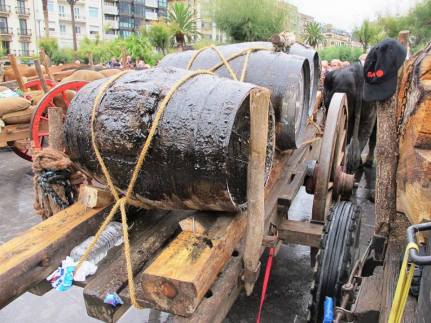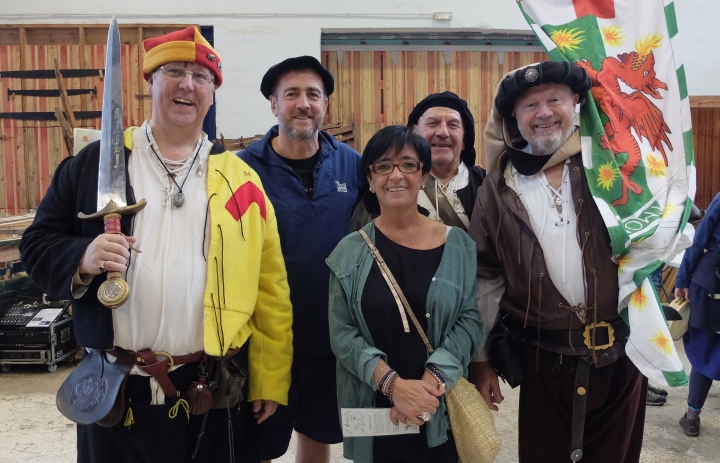The Friends of Newport Ship have been strengthening their relationships with maritime heritage group Albaola, based in Pasaia, near San Sebastian in the Basque Region of Northern Spain.

Barrels of Pine Tar
FoNS were specially invited guests to celebrations surrounding the arrival of the convoy bringing the year’s crop of pine tar from the forests near Burgos, some 300 km away from Pasaia. The tar was transported in barrels loaded onto ox-carts that had already taken 18 days to make the journey.
The arrival of the caravan was celebrated at an event at San Sebastian Town Hall, watched over by the mayor and leaders of several heritage groups. The final segment of the journey took us 4 miles over the hill into Pasaia with the FoNS team in company – with Phil Cox, Charles Ferris and Rob Kenny in appropriate medieval outfits.
En route, we were welcomed into Pasaia by their mayor and we continued through the town, along the river to the Albaola shipyard; following the three ox-carts.

Ox carts in the streets of Pasaia
Albaola, the local maritime heritage group is currently building a full size replica of the San Juan. The original vessel was found on the sea bed in Red Bay, Newfoundland. Built in 1563 by the Basques; this whaling ship was 27m long and had perhaps 6 attendant 11m whalers, each with a crew of 7 to go and catch whales, and tow them back to Red Bay where they would be rendered down and the primary product, whale oil, recovered. The original vessel was preserved by the freezing waters of Red Bay, recovered and researched by Parcs Canada, and now being faithfully replicated by Albaola.
This project has so many synergies with our own Newport Medieval Ship; together creating greater understanding the way that both ships were built. Our own Newport ship predates the San Juan by 114 years, and is a magnificent example of large Basque clinker-built vessels. By the time that the San Juan was built, the technology had changed; she was carvel built, with her frames assembled first and clad with the oak planking.
However the challenges of growing the oak trees, working the timber to create the shapes needed, fixing them with iron rivets and treenails and making a ship strong enough to survive the Atlantic Ocean, are the same.
The San Juan project undertaken by Albaola is ground-breaking and massive. In a town where there is no tourism, they have welcomed 50,000 visitors this year, generating a direct income of over 200,000 Euros. They have created 23 permanent jobs, some welcoming and guiding visitors, but the majority rediscovering skills lost for generations as they work with huge oak trees to create the components for the San Juan.
The project is supported by both local and regional governments, and with a sizeable contribution from corporate sponsors.
Is this a model for the future of the Newport Medieval Ship? The Basques are indeed very keen to follow the San Juan project with another, using our plans – recreating the yet bigger clinker vessel that we have here in Newport.
With all the other attractions that Newport has to offer, it has been estimated by the Council’s consultants, that we might expect over 150,000 additional visitors each year to see the Newport Medieval Ship, potentially generating some £7million to the local economy. Now that’s a huge boost for Newport!
Future collaboration between FoNS and Albaola is likely to take the form of a series of visits and seminars, where each organisation and our members and followers can learn from the experiences of the other.

Charles Ferris (FoNS patron), Xabi Agote (Albaola CEO), the Mayor of Pasaia, Rob Kenny (FoNS Events Coordinator & Phil Cox (FoNS Chairman)



